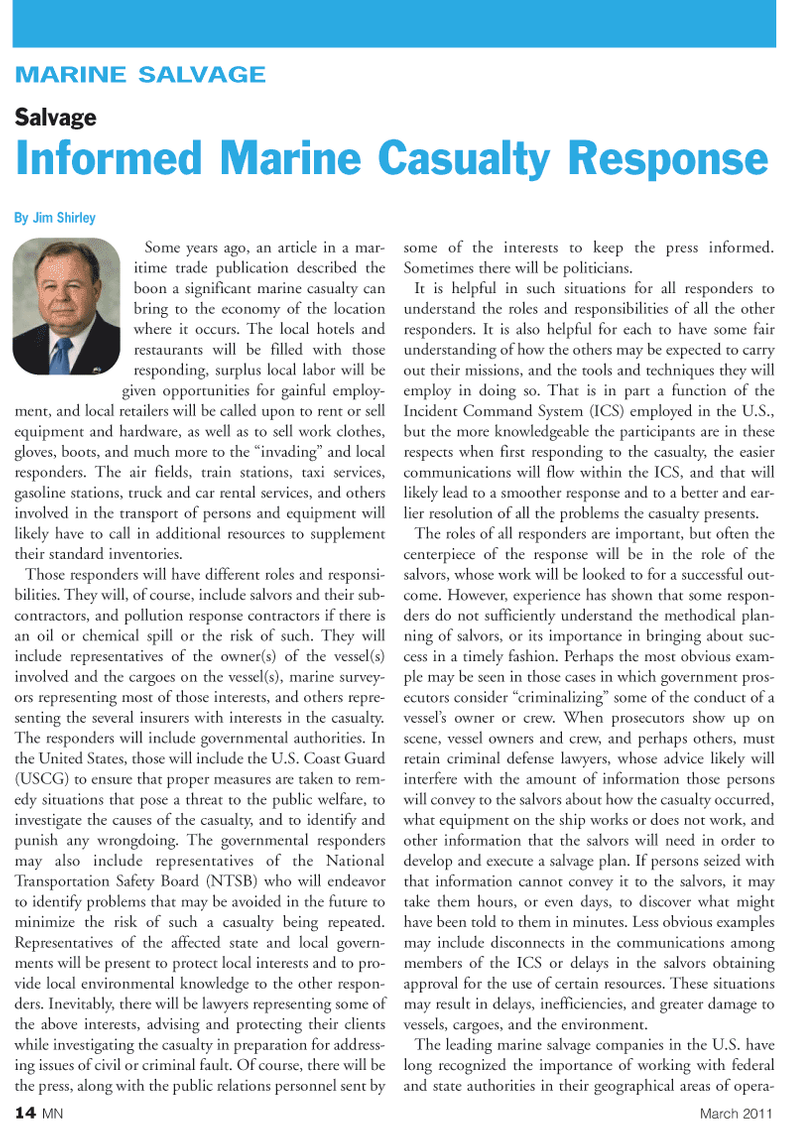
Page 14: of Marine News Magazine (March 2011)
Marine Training & Education Edition
Read this page in Pdf, Flash or Html5 edition of March 2011 Marine News Magazine
14 MN March 2011
MARINE SALVAGE
Some years ago, an article in a mar- itime trade publication described the boon a significant marine casualty can bring to the economy of the location where it occurs. The local hotels and restaurants will be filled with those responding, surplus local labor will be given opportunities for gainful employ- ment, and local retailers will be called upon to rent or sell equipment and hardware, as well as to sell work clothes, gloves, boots, and much more to the “invading” and local responders. The air fields, train stations, taxi services, gasoline stations, truck and car rental services, and others involved in the transport of persons and equipment will likely have to call in additional resources to supplement their standard inventories.
Those responders will have different roles and responsi- bilities. They will, of course, include salvors and their sub- contractors, and pollution response contractors if there is an oil or chemical spill or the risk of such. They will include representatives of the owner(s) of the vessel(s) involved and the cargoes on the vessel(s), marine survey- ors representing most of those interests, and others repre- senting the several insurers with interests in the casualty.
The responders will include governmental authorities. In the United States, those will include the U.S. Coast Guard (USCG) to ensure that proper measures are taken to rem- edy situations that pose a threat to the public welfare, to investigate the causes of the casualty, and to identify and punish any wrongdoing. The governmental responders may also include representatives of the National
Transportation Safety Board (NTSB) who will endeavor to identify problems that may be avoided in the future to minimize the risk of such a casualty being repeated.
Representatives of the affected state and local govern- ments will be present to protect local interests and to pro- vide local environmental knowledge to the other respon- ders. Inevitably, there will be lawyers representing some of the above interests, advising and protecting their clients while investigating the casualty in preparation for address- ing issues of civil or criminal fault. Of course, there will be the press, along with the public relations personnel sent by some of the interests to keep the press informed.
Sometimes there will be politicians.
It is helpful in such situations for all responders to understand the roles and responsibilities of all the other responders. It is also helpful for each to have some fair understanding of how the others may be expected to carry out their missions, and the tools and techniques they will employ in doing so. That is in part a function of the
Incident Command System (ICS) employed in the U.S., but the more knowledgeable the participants are in these respects when first responding to the casualty, the easier communications will flow within the ICS, and that will likely lead to a smoother response and to a better and ear- lier resolution of all the problems the casualty presents.
The roles of all responders are important, but often the centerpiece of the response will be in the role of the salvors, whose work will be looked to for a successful out- come. However, experience has shown that some respon- ders do not sufficiently understand the methodical plan- ning of salvors, or its importance in bringing about suc- cess in a timely fashion. Perhaps the most obvious exam- ple may be seen in those cases in which government pros- ecutors consider “criminalizing” some of the conduct of a vessel’s owner or crew. When prosecutors show up on scene, vessel owners and crew, and perhaps others, must retain criminal defense lawyers, whose advice likely will interfere with the amount of information those persons will convey to the salvors about how the casualty occurred, what equipment on the ship works or does not work, and other information that the salvors will need in order to develop and execute a salvage plan. If persons seized with that information cannot convey it to the salvors, it may take them hours, or even days, to discover what might have been told to them in minutes. Less obvious examples may include disconnects in the communications among members of the ICS or delays in the salvors obtaining approval for the use of certain resources. These situations may result in delays, inefficiencies, and greater damage to vessels, cargoes, and the environment.
The leading marine salvage companies in the U.S. have long recognized the importance of working with federal and state authorities in their geographical areas of opera-
Salvage
Informed Marine Casualty Response
By Jim Shirley

 13
13

 15
15
